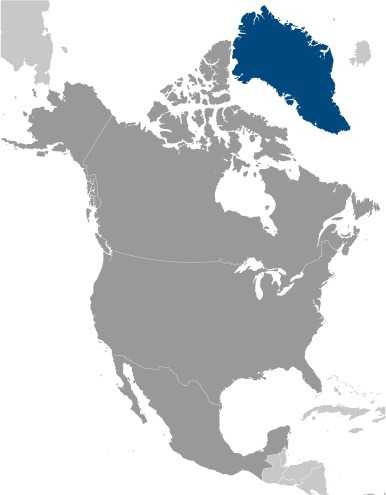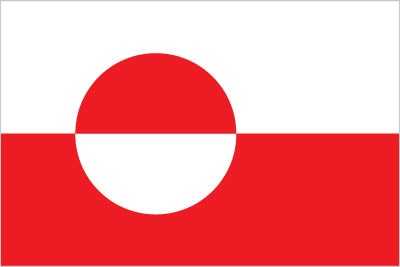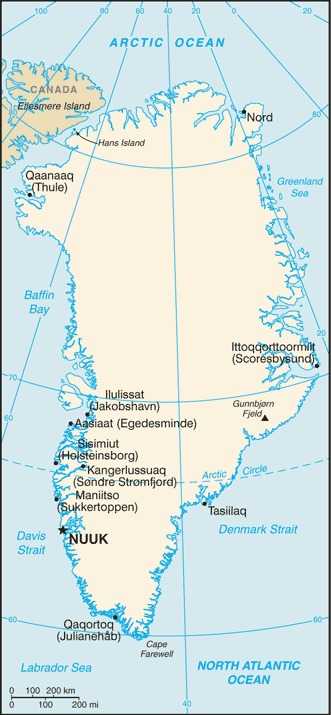Introduction
Background
Greenland, the world's largest island, is about 80% ice-capped. Vikings reached the island in the 10th century from Iceland; Danish colonization began in the 18th century, and Greenland became part of the Danish Realm in 1953.
Geography
Area
total: 2,166,086 sq km
land: 2,166,086 sq km
Climate
arctic to subarctic; cool summers, cold winters
Natural resources
coal, iron ore, lead, zinc, molybdenum, diamonds, gold, platinum, niobium, tantalite, uranium, fish, seals, whales, hydropower, possible oil and gas
People and Society
Population
total: 57,751
male: 29,843
female: 27,908 (2024 est.)
Ethnic groups
Greenlandic 88.1%, Danish 7.1%, Filipino 1.6%, other Nordic peoples 0.9%, and other 2.3% (2024 est.)
Languages
Greenlandic (West Greenlandic or Kalaallisut is the official language; Tunumiisut (East Greenlandic) and Inuktun (Polar Inuit Greenlandic) are two other native languages, considered dialects of Kalaallisut, spoken by approximately 10% of Greenlanders), Danish, English
Religions
Evangelical Lutheran, traditional Inuit spiritual beliefs
Population growth rate
-0.05% (2024 est.)
Government
Government type
parliamentary democracy (Parliament of Greenland or Inatsisartut)
Capital
name: Nuuk
Executive branch
chief of state: King FREDERIK X of Denmark (since 14 January 2024), represented by High Commissioner Julie Praest WILCHE (since May 2022) (2024)
head of government: Premier Mute B. EGEDE (since 23 April 2021)
Legislative branch
description: unicameral Parliament or Inatsisartut (31 seats; members directly elected in multi-seat constituencies by party-list proportional representation vote - by the d'Hondt method - to serve 4-year terms)
Greenland elects 2 members to the Danish Parliament to serve 4-year terms
Economy
Economic overview
large self-governing Danish territorial economy; preferential EU market access; high-income economy; dependent on Danish financial support, even for whaling and sealing industries; growing tourism; hydropower-fueled but environmentally fragile economy
Real GDP (purchasing power parity)
$2.413 billion (2015 est.)
$2.24 billion (2014 est.)
$2.203 billion (2013 est.)
Real GDP per capita
$41,800 (2015 est.)
$38,800 (2014 est.)
$38,500 (2013 est.)
Agricultural products
sheep, cattle, reindeer, fish, shellfish
Industries
fish processing (mainly shrimp and Greenland halibut), anorthosite and ruby mining, handicrafts, hides and skins, small shipyards
Exports
$1.147 billion (2021 est.)
$1.108 billion (2020 est.)
$1.23 billion (2019 est.)
Exports - partners
Denmark 49%, China 24%, UK 6%, Japan 5%, Taiwan 3% (2022)
Exports - commodities
fish, shellfish, processed crustaceans, precious stones, animal products (2022)
Imports
$1.609 billion (2021 est.)
$1.441 billion (2020 est.)
$1.533 billion (2019 est.)
Imports - partners
Denmark 56%, Sweden 22%, France 10%, Iceland 3%, Canada 3% (2022)
Imports - commodities
refined petroleum, aircraft, garments, construction vehicles, plastic products (2022)
Exchange rates
Danish kroner (DKK) per US dollar -
Exchange rates:
6.287 (2021 est.)
6.542 (2020 est.)
6.669 (2019 est.)
6.315 (2018 est.)
6.603 (2017 est.)
Page last updated: Thursday, May 30, 2024




